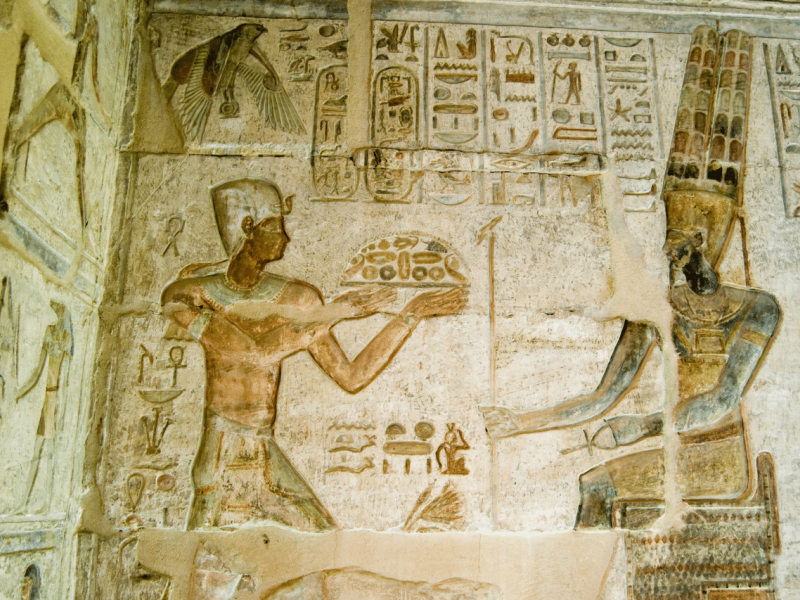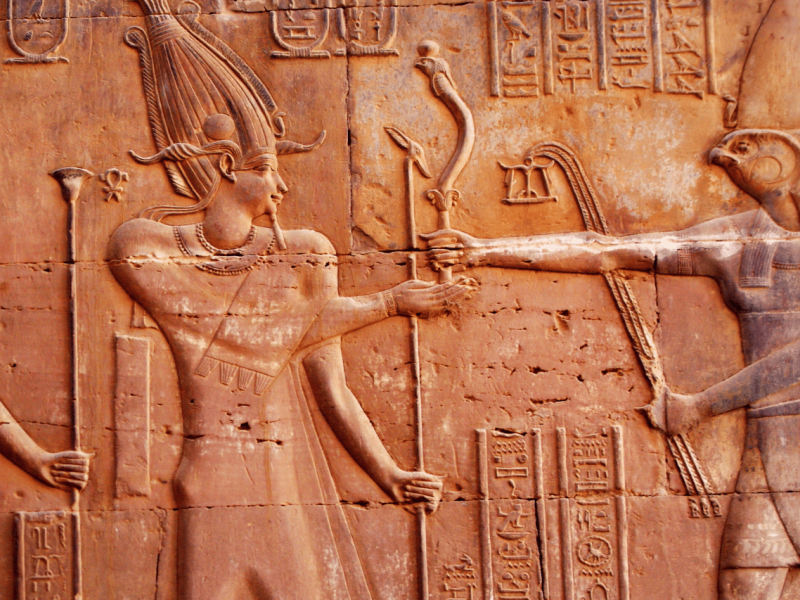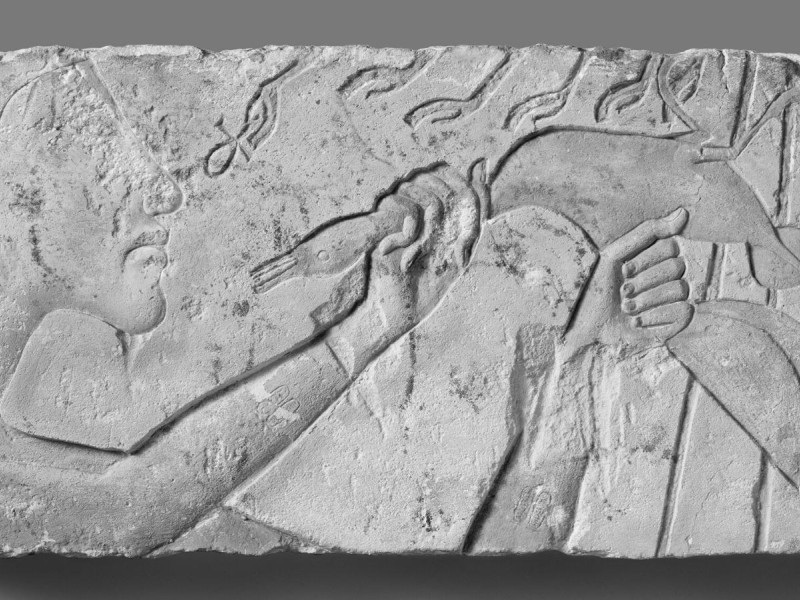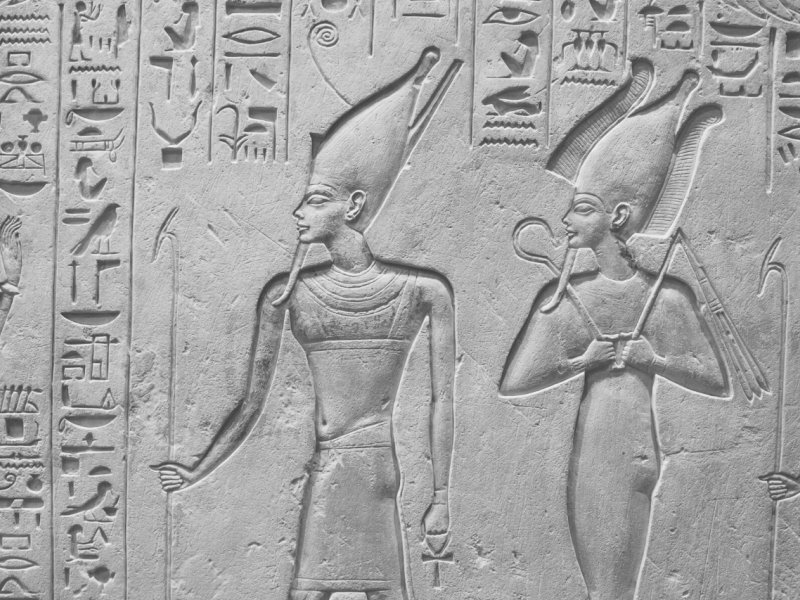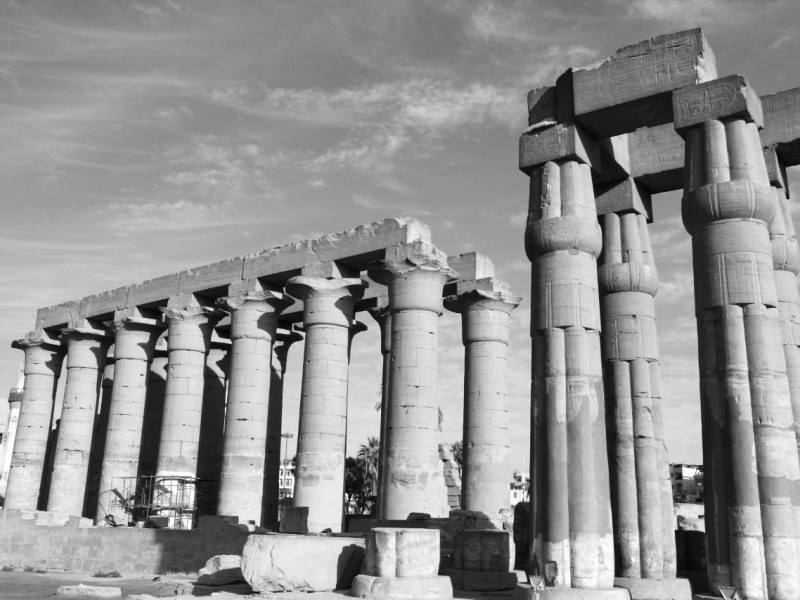Aten
Aten: the Sun God Who Caused a Revolution Within the Egyptian Religion
In this in-depth bio, you will learn who Aten was, his history, and the myths and belief systems behind his name.
You will also learn:
Who Aten was in Egyptian Mythology
How Aten was depicted in Egyptian artwork
The meaning of Aten
The New Religion of Atenism, including Amenhotep IV’s conversion and Aten as the sole god of Egypt
How Aten’s worship differed from that of the old gods of Egypt
Examples of the Principles of Aten
The Great Hymn to the Aten
The End of Aten worship in Egypt
Who was Aten in Egyptian mythology?
In Egyptian mythology, Aten (also referred to as Aton) was the disk of the sun, worshipped as an aspect of Ra. While there are records of Aten being revered as early as 2600 BC during the 3rd Dynasty, during the reign of Amenhotep IV (later renamed Akhenaten and ruling from 1353 – 1336 BC), Aten worship became the state sponsored religion for a small number of years.
As the new religion came into being, Akhenaton’s work, the Great Hymn to the Aten, credited the sun disk with being the creator and giver of all life, and being the world’s great nurturer.
However, unlike worship of other cults in Egypt, after becoming the state religion, all worship of gods other than Aten was banned. In one fell swoop, the ancient Egyptian religion and its wide pantheon of gods were displaced, and the Cult of Aten rose to power.
After a great plague struck Egypt, and the later death of the pharaoh Akhenaten who served as the high priest of Aten, Aten worship lost its short hold on Egypt and the former pantheon of gods was restored. After the short reign of Akhenaten’s son, Tutankhamun, the pharaoh Horemheb destroyed every remaining remnant of Aten worship, eradicating it from existence.
Appearance
Unlike the other gods and goddesses of ancient Egypt, Aten was never represented with a humanoid appearance. Aten was depicted as a round disk with rays emanating from it, often ending in opened human hands. Most representations paired the image with an ankh (the symbol for the key of life). Since Atenism expressed the belief that Aten himself was beyond creation, it was impossible to represent him in artwork.
Near the end of his reign, Akhenaten issued a decree prohibiting even representing the Aten in artwork as a disk, and ordered that when depicting Aten, that his name was to be simply spelled. This led to the unique characteristic of Aten having his name appear on cartouches, usually along with titles that had previously been reserved for pharaohs.
The meaning of Aten
First appearing in the Egyptian language during the Old Kingdom, the word "aten" simply meant disk. The sun was known as the disk of the day and was the home of Ra. Silver aten, conversely, meant moon.
While the Aten was revered as an aspect of Ra, it was not worshiped as a god until the 12th Dynasty (1938 – 1756 BC). The Story of Sinuhe gives the first recorded instance of Aten holding the status of deity, as in the story, a deceased king is said to rise as a god to the heavens to unite with the Aten, the divine body merging with its maker. Mentions of Aten also begin to show up in the funerary spells of The Book of the Dead during this time.
The New Religion of Atenism
During the 12th Dynasty, the Egyptian sun disk came to be worshiped as a god. By the rule of Amenhotep III, the Cult of Aten had arisen and enjoyed extensive worship throughout the kingdoms of Upper and Lower Egypt. During this period, Aten appeared very similar to the god Ra, having a falcon head.
As the worship of a pantheon of gods had been a part of daily Egyptian life for thousands of years, the worship of Aten was considered by many to be simply another facet of belief. However, as the Cult of Aten rose to power, driven by pharaoh Amenhotep IV, soon the Egyptian kingdom found itself amid a religious revolution.
Amenhotep IV’s conversion
During the beginning of his pharaonic reign, Amenhotep IV and his wife Nefertiti, like all past dynastic pharaohs, worshipped the pantheon of gods and goddesses. Like his ancestors, Amenhotep IV believed that he was a god in human form, carrying on the traditions of his ancestors.
During the early reign of Amenhotep IV, the capital did not lay in Memphis but in Thebes, which housed the Great Temple of Amun, which was quite possibly one of the richest temples in the history of ancient Egypt. The power and treasures of the priests of Amun were legendary, and some historians believe their wealth rivaled that of the pharaoh.
It was during this time that Amenhotep IV began to dabble in the worship of the Aten, possibly to weaken the power of the Great Temple of Amun, and also because the pharaoh claimed that Aten was omnipresent and obviously life giving for the earth. Amenhotep IV soon dedicated himself solely to a newly stylized worship of Aten, believing Aten to be the only god and all other gods of Egypt as false.
Renaming himself Akhenaten (also spelled Echnaton, Ikhnaton, Akhenaton, and Khuenaten), which meant Effective for the Aten, the pharaoh proclaimed Atenism the official religion of Egypt, and began to remake the Egyptian faith in his god’s name.
The Rise of Atenism
To establish their religion as the dominant one of Egypt, Akhenaten and his wife Nefertiti soon abandoned their palace in Thebes and moved to their new palace being constructed at the new capital of Akhetaten, a city solely dedicated to the expression of the Aten.
Passing controversial regulations and decrees, soon it became increasingly difficult to publicly worship any deity other than Aten. All temple construction other than that to Aten was banned, and Akhenaten soon began to have reliefs carved with himself and the sun disk, images which symbolically portrayed Akhenaten as the true mother and father of the kingdom.
Seizing power from the priests of Egypt, Akhenaten proclaimed himself as the living representation of the Aten, giving Nefertiti similar powers. While this may not seem remarkable on the surface, what was different was that Aten and Nefertiti were the only representatives of Aten, not the priests. Akhenaten proclaimed that if one wished to receive the life of the Aten, then that life must pass through Akhenaten and Nefertiti first. The Aten shined only upon the royal family, and it was up to them to distribute life to the kingdom as they saw fit.
Aten as the sole god of Egypt
Akhenaten embarked upon a campaign of stripping the cult centers, shrines, and temples of Egypt of their money and power, destroying buildings and monuments throughout the kingdom while using their rubble to build temples to Aten. Not only were temples destroyed in the name of the new god, Aten, but Akhenaten embarked on a campaign of attempting to erase the names of all other gods.
Akhenaten even went so far as to erase the cartouches of his ancestors, even his own father, since they contained the name Amun. For the first time in Egyptian history, there was only one god that would be worshiped. In Akhenaten’s Egypt, there would be no god other than Aten.
Obsessed with building monuments and palaces to the sun god Aten, Akhenaten’s military was left weakened, ceding massive amounts of territory to the Hittites in the east and north. As the Egyptian people witnessed their temples, monuments, priests, beliefs, and civilization being stripped of their might, soon voices began to rise against the worship of Aten.
Worship of the Aten
Aten’s primary cult center was at Akhetaten. In fact, the entire city was designed around the main temple dedicated to Aten. While the former capitals of Thebes, Memphis, and Heliopolis had significant cult centers dedicated to Aten, compared to the city of Ahetaten, they were very minor.
The laws and principles of the Cult of Aten were carved into the rocks of Amarna. Aten’s temples were also open air to allow in the rays of the sun. Whereas the standard temples of Egypt were closed roof and shadowy affairs, Aten’s temples open roof design were bright and exposed.
The doorways of Aten’s temples featured broken lintels and raised thresholds. Combined with the open air of the temples, stepping into a temple of Aten was like stepping into a limitless sacred space. Statuary of Aten were not allowed, as worshiping a statue or representation of Aten was considered idolatry. However, temples did allow iconography of Akhenaten and Nefertiti worshiping Aten and receiving the key to life (ankh) from him.
Since there were no major sacrifices to be made nor ritualistic rules to follow, the functions of priests were minimal in comparison to their former role. The offerings of fruit, cakes, bread, and flowers were the accepted standard instead of animal sacrifice, and the role of oracle was stripped away as well, as the god Aten only spoke to Akhenaton and Nefertiti.
In Atenism, the normal rules of Egyptian worship did not apply. There was no need for daily purification, anointing of idols, or clothing the divine representations of the gods in temples. Instead, temple rites were simple – incense burning at moments throughout the day to honor Aten’s movement across the sky, hymns being sung, and simple harp music instead of large musical processions. Ceremonies to Aten were even simpler affairs, with offerings being presented to Aten through Akhenaten which he would approve of with a simple wave of his royal scepter.
It was expected that the priests honor Akhenaten and Nefertiti as gods. This was not much of a departure from the older religious beliefs of Egypt, as the pharaoh and his family were believed to be descended from the gods and to step further into divinity at death upon rising to the heavens. However, the difference with Atenism was that the priests were to not just honor Akhenaten as a god, but they were to worship him as Aten upon earth.
Principles of Aten
Akhenaten had the Principles of Aten (the beliefs, rules and theology of Atenism) etched into the rock walls of Akhetaten. Some of the most important principles were:
Work was done best when the Aten (the sun) was present
The darkness of night was a time to fear
Aten cared for every creature
Aten created the Nile River in the sky to bring rain and refreshment
Aten created all people and every country to be subject to him
The rays of the sun were meant to only bring life to the royal family, everyone else received life as an exchange for loyalty to Aten
Hymns were to be crafted and offered to Aten
Aten gave to the world through his son, Akhenaton
The living Aten had none beside him; Aten was the sole god
The Great Hymn to the Aten
The Great Hymn to the Aten is the longest of a number of surviving poetic hymns written to the god Aten either by temple courtiers or by Akhenaton himself.
Considered some of the most significant works of literature prior to Homer, the Great Hymns to the Aten were designed to be sung. A number of these Hymns to Aten have been found in the tombs of Akhetaten (modern Amarna), particularly among temple courtiers and even pharaohs (Pharaoh Ay). Outside of tombs, no surviving hymns have been found.
One such example is given below.
The Great Hymn to the Aten
“How manifold it is, what thou hast made!
They are hidden from the face (of man).
O sole god, like whom there is no other!
Thou didst create the world according to thy desire,
Whilst thou wert alone: All men, cattle, and wild beasts,
Whatever is on Earth, going upon (its) feet,
And what is on high, flying with its wings.
The countries of Syria and Nubia, the land of Egypt,
Thou settest every man in his place,
Thou suppliest their necessities:
Everyone has his food, and his time of life is reckoned.
Their tongues are separate in speech,
And their natures as well;
Their skins are distinguished,
As thou distinguishest the foreign peoples.
Thou makest a Nile in the underworld,
Thou bringest forth as thou desirest
To maintain the people (of Egypt)
According as thou madest them for thyself,
The lord of all of them, wearying (himself) with them,
The lord of every land, rising for them,
The Aton of the day, great of majesty.
You are in my heart,
There is no other who knows you,
Only your son, Neferkheprure, Sole-one-of-Re (Akhenatan),
Whom you have taught your ways and your might.
Earth come from your hand as you made them.
When you have dawned they live.
When you set they die;
You yourself are lifetime, one lives by you.
All eyes are on beauty until you set.
All labor ceases when you rest in the west;
When you rise you stir for the King,
Every leg is on the move since you founded the Earth.
You rouse them for your son who came from your body.
The King who lives by Maat, the Lord of the Two Lands,
Neferkheprure, Sole-one-of-Re,
The Son of Re who lives by Maat. the Lord of crowns,
Akhenaten, great in his lifetime;
(And) the great Queen whom he loves, the Lady of the Two Lands,
Nefer-nefru-Aten Nefertiti, living forever.”
Hymn to the Aten - Inspiration for King David?
Biblical scholars have noticed strong parallels between the Egyptian Hymn to the Aten, and Psalm 104 in the Bible. Although this Psalm is not titled in the Masoretic Text of the Old Testament, other variant texts of the Old Testament, such as the Septuagint and the Latin Vulgate, regard it as having been written by David.
King David is traditionally dated to circa 1007-967 BCE, however - roughly three centuries after the time of Akhenaten. Since the Aten hymns didn't survive outside of tombs, why does this literary parallel exist?
Note that some of the Aten hymn parallels are from other hymns, not the same as the one given above.
Hymn to the Aten |
Psalm 104 |
O sole god, like whom there is no other! |
O Lord my God, You are very great |
Thou didst create the world according to thy desire, Whilst thou wert alone: All men, cattle, and wild beasts... |
O Lord, how manifold are Your works! In wisdom You have made them all. The earth is full of Your creatures... |
All eyes are on beauty until you set. All labor ceases when you rest in the west; When you rise you stir for the King, Every leg is on the move since you founded the Earth. |
The sun knows its going down. You make darkness, and it is night, In which all the beasts of the forest creep about. |
Every lion is come forth from his den... |
The young lions roar after their prey, and seek their food from God. When the sun rises, they gather together And lie down in their dens. |
When you have dawned they live. When you set they die. |
You hide Your face, they are troubled; You take away their breath, they die and return to their dust. You send forth Your Spirit, they are created; and You renew the face of the earth. |
Thou settest every man in his place, Thou suppliest their necessities: Everyone has his food, and his time of life is reckoned. |
These all wait for You, that You may give them their food in due season. |
All the world, they do their work... |
Man goes out to his work and to his labor until the evening. |
The fish in the river dart before thy face; Thy rays are in the midst of the great green sea. |
The earth is full of Your possessions; this great and wide sea, in which are innumerable teeming things... |
The birds which fly from their nests, Their wings are (stretched out) in praise to thy ka. |
By them (streams) the birds of the heavens have their home; they sing among the branches. |
Biblical scholars have proposed that a common literary tradition must have existed, to give rise to both the Hymns to the Aten as well as King David's Psalm 104. While that's possible, wouldn't there have been similar Biblical hymns closer in time to the Amarna period?
Egyptologist David Rohl has proposed an alternate, more radical explanation. Instead of Akhenaten preceding King David by roughly three centuries, they were contemporaries. In order for that to be possible, a radical redating of Egyptian chronology is necessary, and most conventional Egyptologists don't support that. Nevertheless, it's interesting to consider the strange connection between Akhenaten and the Biblical King David.
The End of the Aten
Over the last few years of Akhenaten’s reign, a great plague descended upon Egypt. Famine struck as well, and Egypt continued to take heavy military losses, ceding land and territory to the Hittites. The people of Egypt believed that they were suffering at the hands of their forbidden gods, as it was their former gods who kept them safe. And Aten, apparently, could do nothing. Even the royal family was not immune, as sickness descended upon the pharaoh.
As the pharaoh Akhenaten was the High Priest of Aten, at Akhenaten’s death the Cult of Aten fell to his son Tutankhaten. However, unlike his father, Tutankhaten had no love for the sun cult. Upon assuming power, Tutankhaten immediately restored the Cult of Amun to its prior place of honor and lifted the ban on other gods and god cults. He immediately reinstated temple building programs, and restored the Egyptian priesthood.
Tutankhaten then took the step of removing -aten from his pharaonic name and took on -amun, officially ending the Aten’s place as the favored religion of Egypt. Tutankhamun ushered in tolerance of multiple religions and even hesitated in outright destroying the Aten cult, which survived in a greatly reduced form for another decade.
Ten years later, the Cult of Aten was crushed by the pharaoh Horemheb, who razed every building associated with Aten worship and deemed the pharaoh Amenhotep IV (Akhenaten) a heretic. Amenhotep IV’s name was erased from the rolls of the pharaohs, and every known cartouche and piece of artwork depicting Aten and Akhenaten was destroyed.
Aten, the sun god whose worship created a revolution
In Egyptian mythology, Aten was the disk of the sun, worshipped as an aspect of Ra. During the reign of Amenhotep IV (later renamed Akhenaten and ruling from 1353 – 1336 BC), Aten worship became the state sponsored religion for a small number of years, displacing the Egyptian pantheon of gods.
During the 12th Dynasty, Aten began to be worshipped as a deity, with the Cult of Aten rising to power near the end of Amenhotep III’s reign
Upon Amenhotep IV assuming the crown, he soon proclaimed himself a follower of only Aten, passing decrees that all other religions were false. Amenhotep renamed himself Akhenaten, which means effective for Aten
It was illegal for Aten to be represented as any other way than a disk in the sky, as Aten existed before existence. Aten did not have a humanoid form, nor would statuary of him be permitted
Akhenaten and his wife, Nefertiti, abandoned the capital of Thebes, building a palace in a city completely dedicated to Aten, Akhetaten
Akhenaten forbid the funding of temples to other gods, proclaiming Aten was the only true religion allowed in Egypt. The rays of Aten only fell upon the royal family, and the royal family would then distribute blessings upon people proclaiming fealty to Aten
Akhenaten began a campaign of tearing down temples to other gods and removing their priests, taking their treasures and offerings for Aten
Egypt’s fund depleted military soon began suffering major territorial losses, and by the end of the decade a great plague and famine descended upon Egypt
After the death of Akhenaten, Aten’s pharaonic high priest, Akhenaten’s son Tutankhaten assumed the throne
Tutankhaten immediately reinstated the pantheon of Egyptian gods and ushered in an age of religious tolerance, removing Aten as the state religion. Tutankhaten then took the name Tutankhamun, effectively restoring the authority of the gods of ancient Egypt over his reign
After Tutankhamun’s death, the pharaoh Horemheb crushed the remaining Cult of Aten, razed its temples, and destroyed its remaining momnuments. Horemheb declared Amenhotep IV (Akhenaten) a heretic, and erased his name from the pharaonic roles
While the ancient Egyptians tried to erase all traces of Aten, archeological evidence remains of this tumultuous time of Egypt’s history in the caves and tombs of Amarna. Aten may have shined upon Akhenaten, but Egypt’s people were not yet ready to only worship one god. Within a generation, Aten was forgotten and left to forgotten tombs.




